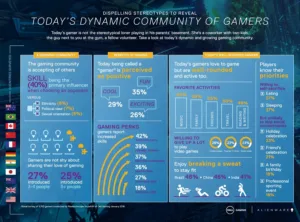The gaming market exceeded $30 billion in 2016 and is forecast to grow at a CAGR of 6% through 2019, according to Dell. The company’s gaming subsidiary, Alienware, partnered with a third-party research firm, Researchscape, to conduct an extensive online survey of 5,763 gamers from 11 countries — Australia, Brazil, Canada, China, France, Germany, India, Japan, New Zealand, UK and the US — on today’s gaming habits, attitudes and the wider gaming community. To qualify for the study, respondents had to play videogames on desktops or laptops for at least an hour a week. The survey results indicate that today’s gamer is not the stereotypical teen boy, but they all have one thing in common — they proudly call themselves a “gamer.”
According to those surveyed, fewer than one in 10 feel either “judged,” “childish” or “embarrassed” being called a gamer (8-9% each). Instead, they consider “gamer” a positive label and feel “fun” (35%), “cool” (29%), or “excited” (26%) as a result. 27% have introduced three to four friends or family members to gaming, and 25% having introduced five or more. People are increasingly turning to videogames for relaxation (60% of respondents), passing the time (51%) and relieving stress (49%).
A little under half (40%) of gamers are not concerned with their skill level. Just under 6% identified as “noobs” (gamer-speak for a novice player) while 14% consider themselves to be just beyond “noob” level. 40% identify as casual gamers, 25% as “pretty darn good”, and 8% feel they can compete with pro gamers. Gaming for a living can net a pretty penny, with some of the top players bringing in as much as $500,000 a month for their videos.
When it comes to being matched with rival gamers, culture/ethnicity (8%), political views (7%), and sexual orientation (6%) are for the most part inconsequential to a player. What matters most is the other gamer’s skill level (40%). Only 14% of gamers said they care about the gender of the rivals they are matched with online, which could explain the sharp increase in female gamers in recent years. One in two players (47%) has a female friend who plays videogames. Almost a third (29%) have a sister who plays, and 21% said their daughter does. Only 17% of gamers reported a need to recruit more women to their gaming community, though a quarter of teenagers wanted to create a more welcoming environment for female players.
When not gaming, their attention is spent on music (63%) and spending time with family (59%) or friends (55%). Travelling (50%) and reading and writing (46%) were also popular. Players in Brazil (52%), France (58%), and Canada (49%) in particular are more inclined than others to be more curious and want to learn about new things.
Gamers in Brazil (46%), China (46%), and India (41%) enjoy staying fit, while Canadian gamers prioritise quality time with family (68%), friends (64%), and pets (40%). Their American neighbours are more inclined than anyone to spend time with their pets (45%) and are almost as sports-mad as the PC gamers from India are (46% versus 58%).
Close to four out of 10 survey respondents said that, because of gaming, they are more strategic thinkers (39%), have improved hand-eye coordination (37%) and increased reaction time (36%). Some even perceive that their teamwork (27%) and leadership (18%) skills have improved. This aligns with research conducted by the Royal Melbourne Institute of Technology, Australia which found teens who were regular gamers scored higher than average in maths, reading and science on an international exam.
54% of gamers at pro level claimed that gaming has made them more strategic thinkers, while 36% of casual players and 30% of “noobs” said the same. Similar patterns occur for technology skills — 42% of pros said they are more tech-savvy compared to 18% of casual players and only 14% of “noobs”.
Gamers spend a median of six to nine hours per week playing video games with 25% spending 10-19 hours and 21% spending 20 or more hours per week playing. Players say they know gaming is their priority when they feel like sacrificing sleep (37%) and eating (27%). However, less than one in four said they would bail on holiday celebrations (23%), a friend’s celebration (21%), a family birthday (18%), or a professional sporting event (18%) to game instead.
Only 30% of respondents said they play VR/AR and/or mixed reality PC games, an average of six hours per week. Even with the growing accessibility of VR headsets and systems, there is still great opportunity for VR growth amongst PC gamers. When asked what they are most excited about when they think about the future of gaming, nearly a quarter mentioned tetherless VR (24%) and 20% mentioned virtual arcades.

